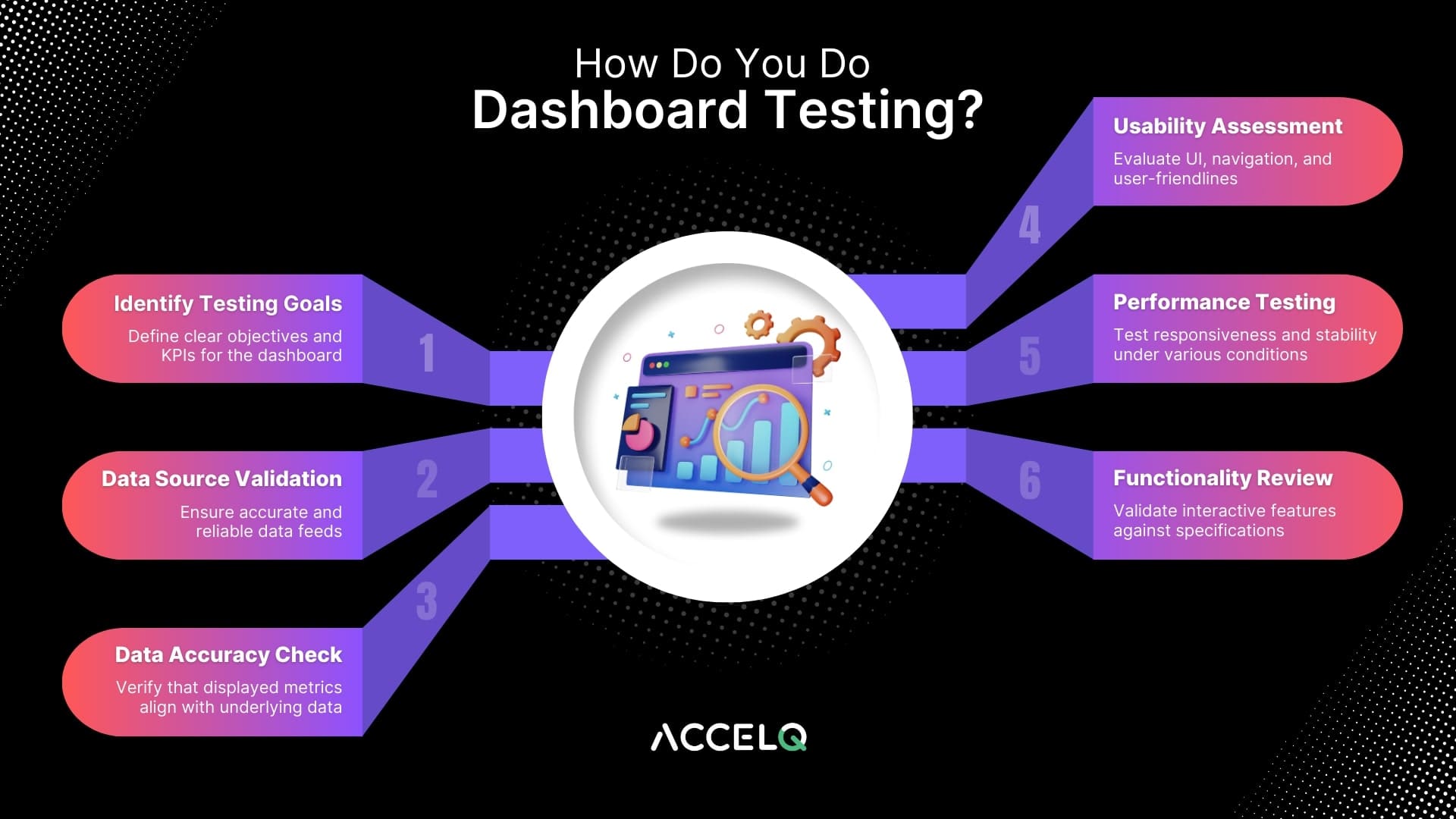Test Dashboards in Agile Software Development

Visuals are a fantastic way to present complicated information in an easy-to-understand manner. Pictures are better than lengthy, boring texts. Test Dashboard is one of the many visual tools that test engineering teams use to communicate complex information in a way that is simple to comprehend. Software applications are getting more complex, and so do the testing. Test engineering teams have to adopt various layers of testing at different intensities to build better test coverage for these complex applications.
Why Testing Dashboards?
Teams and business stakeholders, whether in small startups or large corporations, are often spread across multiple locations and time zones. Test engineering teams find it crucial to have a single, always-accessible source of information. This ensures that everyone is aligned and supports the complexities involved in modern software development.
- Single Source of Information: Facilitates consistent communication and coordination across geographical boundaries.
- Efficiency in Creation: With tools like ACCELQ, the time and effort needed to create and maintain dashboards are significantly reduced.
- Improved Decision Making: Business teams gain strategic insights for risk management, while development teams see enhancements in code quality and problem resolution.
- Better Collaboration and Alignment: This leads to a more transparent, efficient, and collaborative software development process that aligns closely with business goals.
How Do You Do Dashboard Testing?
The quality, dependability, and readability of the test dashboards utilized in Agile software development depend heavily on dashboard testing.
1. Identify Testing Goals
Find out first what the dashboard testing's main objectives are. Decide which measurements and key performance indicators (KPIs) the dashboard should depict fairly. Assign precise goals, including responsiveness, usability, performance, and data quality.
2. Test Data Sources
Make sure that the dashboard receives correct and trustworthy data streaming into it. To be sure the data on the dashboard is accurate and up to date, check data integration points, database connections, and data pipelines.
3. Check Data Accuracy
Check the original data sources with the information shown on the dashboard. Check that the metrics, charts, and graphs really represent the underlying data. Test for consistency and integrity of the data among several views and reports.
4. Examination of Usability and User Interface
Test the user interface (UI) of the dashboard to assess its usefulness. Verify that the navigation works flawlessly, the design is user-friendly, and the layout is understandable. Test the usability with end users to get input and make required changes.
5. Performance Testing
Examine how the dashboard performs in different settings. Examine loading times, data refresh rates, and user interaction responsiveness. Verify that the dashboard runs well and crashes not too often, even with big datasets and many users.
6. Functionality Testing
View every interactive feature on the dashboard, including sorting choices, drill-downs, and filters. Make that these functions operate as intended and yield the desired outcomes. Verify that the features of the dashboard correspond with the given specifications.
SUGGESTED READ - What Is Functional Testing? Process & Examples
Benefits of test dashboards in Agile test engineering teams
Enhanced Visibility
Software testing dashboards contribute to enhanced visibility through real-time monitoring of testing activities. Real-time insight allows stakeholders, including developers, testers, and project managers, to track the status of test executions, identify potential bottlenecks, and instantly gauge the testing phase's overall health.
Better Collaboration
Traditional engineering teams relied on the testing team to prepare a report that included detailed information about the progress of the test, which resulted in delays and extra work for wider team members or stakeholders. We are removing delays and paving the way for improved collaboration with various tiers of team members by making live data available and accessible to all members of an organization, fostering better collaboration.
Data-Driven Decisions
Test dashboards combine numerous testing metrics into a single, user-friendly interface. A thorough picture of the testing environment is readily available to stakeholders, encompassing everything from test case execution rates to defect trends and test coverage. Teams can evaluate the state of the testing phase and make strategic decisions based on hard data points, thanks to the abundance of information that forms the basis of data-led decision-making.
Customizable Details
Enhanced visibility doesn't mean inundating stakeholders with irrelevant information. Test dashboards offer the flexibility to customize views based on the needs of different stakeholders. Project managers might be interested in high-level progress and overall testing trends, while testers may want to drill down into specific test case results. By tailoring the dashboard views, each stakeholder can focus on the information most relevant to their role, ensuring that everyone has a personalized and comprehensive view of the testing landscape.
Trend Analysis
Test dashboards provide longer-term trend analysis in addition to current metrics. By visualizing historical data, teams can spot patterns, identify reoccurring problems, and forecast possible difficulties in upcoming testing stages. Teams can anticipate problems, take proactive measures to resolve them, and continuously improve their testing strategies using historical performance data.
Tailored Insights
Different stakeholders need different sets of information to make decisions. Dashboard testing in Agile Software Development is aware of this and offers views that can be customized to meet the unique requirements of various team roles. While testers may delve into specific test case results, project managers may concentrate on high-level progress and the project's overall health. Thanks to this customization, every stakeholder will have access to the information most relevant to their decision-making duties.
Challenges of test dashboards in Agile test engineering
Overstressing on Metrics
Metrics are important, but placing too much emphasis on them can create a culture where hitting numbers becomes the main goal, which could lower the caliber of testing initiatives.
Set up complexity
Complexity may arise during the implementation and upkeep of a test dashboard if teams are unclear about the important KPIs to the team and the company. It's possible for teams to devote more time to dashboard management than to the actual testing tasks.
Misinterpretation of Metrics
Teams must ensure that users clearly understand the metrics presented, especially non-technical users, or else there is a chance of misinterpreting the data, leading to incorrect calculations.
Conclusion
Test dashboards are useful instruments for raising awareness throughout the whole testing process. The transparency that fosters better teamwork benefits users of all skill levels. They also serve as catalysts for businesses to make data-driven decisions. ACCELQ helps with the dashboards and gives teams extensive metrics, traceability matrices, trend analysis, real-time monitoring, customizable views, and proactive alerts to make well-informed decisions based on solid data. Get your ACCELQ free trial today.
Suma Ganji
Senior Content Writer
Expertly navigating technical and UX writing, she crafts captivating content that hits the mark every time. With a keen SEO understanding, her work consistently resonates with readers while securing prime online visibility. When the day's work ends, you'll find her immersed in literary escapades in her quaint book house.
Discover More
 A Complete Overview of Pega Testing
A Complete Overview of Pega Testing
A Complete Overview of Pega Testing
 Here’s How You Can Enable Full-Stack Enterprise Automation with Zero Coding
Here’s How You Can Enable Full-Stack Enterprise Automation with Zero Coding

































